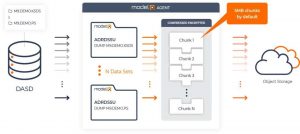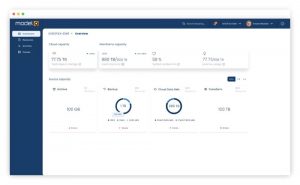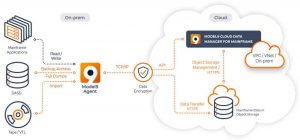It’s Time to Say Goodbye to VTL for Mainframes
Said Model9 CEO Gil Peleg
This is a Press Release edited by StorageNewsletter.com on August 16, 2021 at 2:02 pmBy Gil Peleg, founder and CEO, Model9
Why did it take so long? For decades, mainframe operations have had to work around the snail’s pace capabilities of VTLs. It’s a situation that has been holding back mainframe organizations and costing money, and it’s even worse if you are still dependent on physical tape itself. It’s been one of those ‘that’s-just-the-way-things-are’ situations waiting for someone to say, ‘enough!’
Now, a team of mainframers have done just that, building a software-only solution that is threatening to make tape and everything related to tape (including VTLs) completely obsolete, saving money and boosting performance at the same time.
Click to enlarge
Model9’s Cloud Data Manager for Mainframe packs a combination of capabilities that squeezes extra performance from mainframe backup and archive processes by leveraging cloud and TCP/IP to enhance storage efficiency. In addition, its Cloud Data Sets functionality allows to R/W directly from the cloud – providing the same outcome as tape, but without the complexity and need for a tape management system.
Click to enlarge
Two examples from financial sector demonstrate how effectively Model9 technology can be used:
-
US-based bank switched out their Oracle StorageTek Virtual Storage Manager (VSM) System for Model9, using it to push data to object storage in the Azure public cloud. The headline result: full volume dumps requiring one-twentieth of the usual time to complete. Instead of taking an entire day to complete writing a weekend backup job to VTL, Model9 was able to rocket the same data to the Azure Cloud in just 1h 11min. (The full 2.2TB volume dump backup using VSM took 24 hours, with 27MB/s ingestion. That went to 547.96MB/s, with 102.89MB/s network throughput, with Model9 and Azure.)
-
An EMEA bank had similar improvements. Replacing IBM data management software gave them 17x movement of a DB2 image copy archive, writing directly to IBM Cloud Object Storage (COS). Furthermore, in contrast with using IBM TCT solution to move data, which had required the use of even more DASD to handle all the reads and writes, Model9 did not require DASD space for backups at all. (In this case, the IBM solution delivered the 1.5TB archive in 6 hours at a 70MB/s ingestion rate while Model9’s Cloud Data Manager for Mainframe moved a 1.1TB archive in 21 minutes at a 908MB/s).
Click to enlarge
So, what’s under the hood? The company says its power comes from a singular focus on increasing ingestion throughput. In addition to using zIIP engines and multi-agent load-balancing, Model9 implements data compression, can utilize the z15’s on-chip compression (or zEDC compression cards for pre-z15 architectures), and moves data in parallel as much as possible to reduce or eliminate bottlenecks. The company notes that this magic not only reduces the burden on the mainframe CPU, it also reduces MSU charges.
What is also striking is the ease with which organizations have adopted Model9. Implementation and operation are intuitive, and there is almost no alteration in ‘normal’ operations, just a new ‘superhighway’ that delivers faster and more flexible operations.
Resources:
Blog: Case study: Faster than VTL
Case studies for those interested in shifting out of slow mode and into a more modern approach to backup and archivinginfr

















 Subscribe to our free daily newsletter
Subscribe to our free daily newsletter

